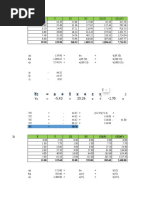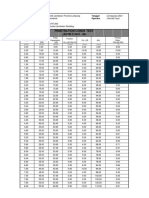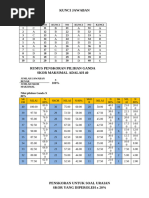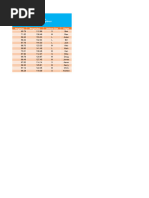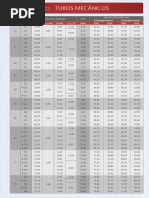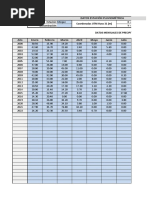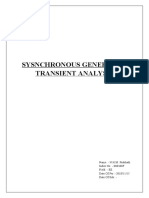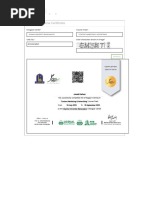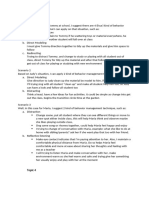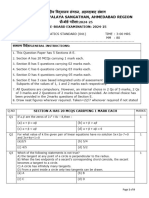0 ratings0% found this document useful (0 votes)
26 viewsGPA Table - 055836
GPA Table - 055836
Uploaded by
Muhammad Junaid HafeezThe document shows the grading scales for two subject areas worth 60 marks and 40 marks. It lists the corresponding grade point average (GPA), percentage, and letter grade achieved based on different total marks in each subject area. The grading becomes more stringent as the marks increase, with higher marks needed to obtain the same GPA and letter grade. It also provides a formula to calculate an overall GPA based on adding the GPA of individual subjects and dividing by the total number of subjects.
Copyright:
© All Rights Reserved
Available Formats
Download as PDF, TXT or read online from Scribd
GPA Table - 055836
GPA Table - 055836
Uploaded by
Muhammad Junaid Hafeez0 ratings0% found this document useful (0 votes)
26 views2 pagesThe document shows the grading scales for two subject areas worth 60 marks and 40 marks. It lists the corresponding grade point average (GPA), percentage, and letter grade achieved based on different total marks in each subject area. The grading becomes more stringent as the marks increase, with higher marks needed to obtain the same GPA and letter grade. It also provides a formula to calculate an overall GPA based on adding the GPA of individual subjects and dividing by the total number of subjects.
Original Title
GPA Table_055836
Copyright
© © All Rights Reserved
Available Formats
PDF, TXT or read online from Scribd
Share this document
Did you find this document useful?
Is this content inappropriate?
The document shows the grading scales for two subject areas worth 60 marks and 40 marks. It lists the corresponding grade point average (GPA), percentage, and letter grade achieved based on different total marks in each subject area. The grading becomes more stringent as the marks increase, with higher marks needed to obtain the same GPA and letter grade. It also provides a formula to calculate an overall GPA based on adding the GPA of individual subjects and dividing by the total number of subjects.
Copyright:
© All Rights Reserved
Available Formats
Download as PDF, TXT or read online from Scribd
Download as pdf or txt
0 ratings0% found this document useful (0 votes)
26 views2 pagesGPA Table - 055836
GPA Table - 055836
Uploaded by
Muhammad Junaid HafeezThe document shows the grading scales for two subject areas worth 60 marks and 40 marks. It lists the corresponding grade point average (GPA), percentage, and letter grade achieved based on different total marks in each subject area. The grading becomes more stringent as the marks increase, with higher marks needed to obtain the same GPA and letter grade. It also provides a formula to calculate an overall GPA based on adding the GPA of individual subjects and dividing by the total number of subjects.
Copyright:
© All Rights Reserved
Available Formats
Download as PDF, TXT or read online from Scribd
Download as pdf or txt
You are on page 1of 2
For 60 Marks For 40 Marks
Marks GPA Percentage Grade Marks GPA Percentage Grade
60 4.00 100 A+ 40 4.00 100 A+
59 4.00 98 A+ 39 4.00 98 A+
58 4.00 97 A+ 38 4.00 95 A+
57 4.00 95 A+ 37 4.00 93 A
56 4.00 93 A+ 36 4.00 90 A
55 4.00 92 A+ 35 4.00 88 A
54 4.00 90 A 34 4.00 85 A
53 4.00 88 A 33 4.00 83 A
52 4.00 87 A 32 4.00 80 A
51 4.00 85 A 31 3.90 78 B+
50 4.00 83 A 30 3.70 75 B+
49 4.00 82 A 29 3.50 73 B+
48 4.00 80 A 28 3.30 70 B
47 3.90 78 B+ 27 3.20 68 B
46 3.80 77 B+ 26 3.00 65 B
45 3.70 75 B+ 25 2.90 63 C
44 3.50 73 B 24 2.70 60 C
43 3.50 72 B 23 2.50 58 C
42 3.30 70 B 22 2.30 55 C
41 3.20 68 B 21 2.20 53 C
40 3.10 67 B 20 2.00 50 C
39 3.00 65 B 19 1.90 48 D
38 2.90 63 C 18 1.70 45 D
37 2.80 62 C 17 1.50 43 D
36 2.70 60 C 16 1.30 40 D
35 2.50 58 C 15 0.00 38 -
34 2.50 57 C 14 0.00 35 -
33 2.30 55 C 13 0.00 33 -
32 2.20 53 C 12 0.00 30 -
31 2.10 52 C 11 0.00 28 -
30 2.00 50 C 10 0.00 25 -
29 1.90 48 D 9 0.00 23 -
28 1.80 47 D 8 0.00 20 -
27 1.70 45 D 7 0.00 18 -
26 1.50 43 D 6 0.00 15 -
25 1.40 42 D 5 0.00 13 -
24 1.30 40 D 4 0.00 10 -
23 0.00 38 - 3 0.00 8 -
22 0.00 37 - 2 0.00 5 -
21 0.00 35 - 1 0.00 3 -
20 0.00 33 - 0 0.00 0 -
19 0.00 32 -
18 0.00 30 -
17 0.00 28 -
16 0.00 27 -
15 0.00 25 -
14 0.00 23 -
13 0.00 22 -
12 0.00 20 -
11 0.00 18 -
10 0.00 17 -
9 0.00 15 -
8 0.00 13 -
7 0.00 12 -
6 0.00 10 -
5 0.00 8 -
4 0.00 7 -
3 0.00 5 -
2 0.00 3 -
1 0.00 2 -
0 0.00 0 -
Ahmad Murtaza
GPA = (SUBJECT A) + (SUBJECT B) + (SUBJECT C).... / NUMBER OF SUBJECTS
You might also like
- SEPEDI Novel 1 Kgalagalo Tsa SetuDocument95 pagesSEPEDI Novel 1 Kgalagalo Tsa SetuTumi75% (4)
- Hodder Assessment WEBDocument40 pagesHodder Assessment WEBvitoavNo ratings yet
- Vocabulary Size and The Common European Framework of Reference For LanguagesDocument18 pagesVocabulary Size and The Common European Framework of Reference For LanguagesMinnah ElNo ratings yet
- Areas y VolummDocument22 pagesAreas y VolummRicardo Leandro Chinguel CruzNo ratings yet
- Copia de Círculo de Mohr, Tensión PlanaDocument5 pagesCopia de Círculo de Mohr, Tensión Planalaura Salazar telloNo ratings yet
- 20CEDocument1 page20CEkaliabala420No ratings yet
- TubingDocument11 pagesTubingLan MendietaNo ratings yet
- LaboratoriosDocument101 pagesLaboratoriosAnaNo ratings yet
- Laboratorium Mekanika Tanah: Politeknik Negeri Bandung - Jurusan Teknik SipilDocument8 pagesLaboratorium Mekanika Tanah: Politeknik Negeri Bandung - Jurusan Teknik SipilMuhammad Rianto SyafeiNo ratings yet
- Data SondirDocument31 pagesData SondirAmelia RossaNo ratings yet
- Laboratorium Mekanika Tanah: Politeknik Negeri Bandung - Jurusan Teknik SipilDocument8 pagesLaboratorium Mekanika Tanah: Politeknik Negeri Bandung - Jurusan Teknik SipilMuhammad Rianto SyafeiNo ratings yet
- S-1 OkeDocument6 pagesS-1 OkeDearexifauzi DLNo ratings yet
- S.1 Parung BangkongDocument3 pagesS.1 Parung BangkongAde SetiawanNo ratings yet
- Tabela Valores Sensores Maquinas Serie A e GDocument1 pageTabela Valores Sensores Maquinas Serie A e GArthur OliveiraNo ratings yet
- Données Diatomées-SimplifiéesDocument8 pagesDonnées Diatomées-Simplifiéesaleynabasay8No ratings yet
- Br. Profila Stacinaza P D (Pa+Pb) /2 V Kolicina Iskopa A1-C4/4-7Document6 pagesBr. Profila Stacinaza P D (Pa+Pb) /2 V Kolicina Iskopa A1-C4/4-7Nevena CrnogoracNo ratings yet
- Tabela de Perda de CargaDocument2 pagesTabela de Perda de CargaJorge Hahns100% (1)
- KUNCI JAWABAN PAT Seni Budaya Kelas 8Document2 pagesKUNCI JAWABAN PAT Seni Budaya Kelas 8officialsmpitalfathjalen2023No ratings yet
- KUNCI JAWABAN PAT SENI BUDAYA KELAS 8 - WWW - Kherysuryawan.idDocument2 pagesKUNCI JAWABAN PAT SENI BUDAYA KELAS 8 - WWW - Kherysuryawan.idAprianiNo ratings yet
- Table 7. Friction Losses TableDocument4 pagesTable 7. Friction Losses TableAnonymous ilWXWxgNo ratings yet
- UJI TANAH Kelompok 1 B3L0M 53L3541Document23 pagesUJI TANAH Kelompok 1 B3L0M 53L354112. Kartika Prami DewiNo ratings yet
- Penetration Conus Test: (ASTM D 3441 - 86)Document4 pagesPenetration Conus Test: (ASTM D 3441 - 86)Eswin SoslindoNo ratings yet
- Data Sondir: Depth CW TW KW QC LF LF X 20 CM JHP FR (M) (TW - CW) (KG/CM) (KG/CM) (%) (KG/CM) (KG/CM) (KG/CM) (KG/CM)Document3 pagesData Sondir: Depth CW TW KW QC LF LF X 20 CM JHP FR (M) (TW - CW) (KG/CM) (KG/CM) (%) (KG/CM) (KG/CM) (KG/CM) (KG/CM)Tri PrasetyoNo ratings yet
- Estaca Ac Ar D VC Vcms Vcrs VCRF VR Propio Lateral TransporteDocument14 pagesEstaca Ac Ar D VC Vcms Vcrs VCRF VR Propio Lateral TransporteLuis Castro Prieto FarfanNo ratings yet
- Convetion Drying FDocument20 pagesConvetion Drying FHoàng Bích NgọcNo ratings yet
- KUNCI JAWABANDocument2 pagesKUNCI JAWABANmuhammadkahfi271No ratings yet
- Form SondirDocument9 pagesForm SondirA raisNo ratings yet
- Perhitungan Metode Bina MargaDocument36 pagesPerhitungan Metode Bina MargahadityaNo ratings yet
- Way Sabuk Sondir 1 Dan Sondir 2Document8 pagesWay Sabuk Sondir 1 Dan Sondir 2Eswin SoslindoNo ratings yet
- Espectro De Diseño Sismico Gbds: Espectro Zona 3-Suelo S4 (1.5 Kg/cm2>σadm ≥ 0.5Kg/cm2)Document4 pagesEspectro De Diseño Sismico Gbds: Espectro Zona 3-Suelo S4 (1.5 Kg/cm2>σadm ≥ 0.5Kg/cm2)OscarQuirogaNo ratings yet
- Catalog Coturi Sudabile 90ENDocument3 pagesCatalog Coturi Sudabile 90ENDanut AnghelNo ratings yet
- 100 Days Challenge Boom and CrashDocument4 pages100 Days Challenge Boom and CrashIsheanesu MusakwaNo ratings yet
- Weight List of Various Laminated SheetsDocument1 pageWeight List of Various Laminated SheetsAli HashemiNo ratings yet
- 01 - Computos CanalDocument9 pages01 - Computos Canalgeinny villaNo ratings yet
- DPL 1 Jorge David Pally Canaza 13 de Diciembre Del 2019 ClintonDocument16 pagesDPL 1 Jorge David Pally Canaza 13 de Diciembre Del 2019 ClintonTANIA YESSICA SOTO QUISPENo ratings yet
- Sondir - RUKO 3 LANTAI JL MT HARYONO SMGDocument9 pagesSondir - RUKO 3 LANTAI JL MT HARYONO SMGMuhammad Nurwahid MNo ratings yet
- Lab Activity K-Nearest Neighbors DataSheetDocument2 pagesLab Activity K-Nearest Neighbors DataSheetGurdeep KaurNo ratings yet
- Load ChartDocument4 pagesLoad ChartFays RiskyNo ratings yet
- Uraian Hasil: 1. Sondir: SondirDocument7 pagesUraian Hasil: 1. Sondir: SondirShofyan AliibrohimNo ratings yet
- Tabelas_TubosMecanicosDocument6 pagesTabelas_TubosMecanicosLeonardo Altermann SerpaNo ratings yet
- 300 Hari Menuju Bebas Financial Target Pips Per Hari: 20 Pips Leverage: 1:200 Margin: 10%Document7 pages300 Hari Menuju Bebas Financial Target Pips Per Hari: 20 Pips Leverage: 1:200 Margin: 10%shah farizNo ratings yet
- PoojaChandrasekaran ExcelDocument19 pagesPoojaChandrasekaran ExcelDharshini RajkumarNo ratings yet
- His To GramsDocument288 pagesHis To Gramssurbhiaggarwal13No ratings yet
- Centragem Externa Centragem Interna Ext. Int. D.Ext. (+/-) MM Parede (+/-) / % KG/M D.Ext. D.Int - D.Ext. D.IntDocument6 pagesCentragem Externa Centragem Interna Ext. Int. D.Ext. (+/-) MM Parede (+/-) / % KG/M D.Ext. D.Int - D.Ext. D.IntsamuelNo ratings yet
- Tabela Peso Teórico Tubos MecânicosDocument6 pagesTabela Peso Teórico Tubos MecânicosMário PedroNo ratings yet
- Idf Mizque PmaxDocument77 pagesIdf Mizque Pmaxjose luis urquidi bareaNo ratings yet
- 000 Abc 3Document51 pages000 Abc 3nelson jose romero montielNo ratings yet
- Ejercicio Métodos Punto EquivalenciaDocument5 pagesEjercicio Métodos Punto EquivalenciaMario Suarez GiraldoNo ratings yet
- Form SondirDocument3 pagesForm SondirTri Prasetyo100% (1)
- Triaksial Kelompok 6Document4 pagesTriaksial Kelompok 6Nurul Azisah NasirNo ratings yet
- Sysnchronous Generator Transient AnalysisDocument18 pagesSysnchronous Generator Transient AnalysisMilinda PrabhathNo ratings yet
- 2.4.1.cubicación de Depósito.Document4 pages2.4.1.cubicación de Depósito.diegarsaNo ratings yet
- Perhitungan Unconfined TestDocument56 pagesPerhitungan Unconfined TestGents HeydNo ratings yet
- UntitledDocument6 pagesUntitledRBV DESIGN & BUILD SERVICESNo ratings yet
- Coba 2Document2 pagesCoba 2Ichal JhyNo ratings yet
- DIN 2093 UNI 8737 Molle A TazzaDocument6 pagesDIN 2093 UNI 8737 Molle A TazzaRoby MastreNo ratings yet
- CreditDocument6 pagesCredityiqi wuNo ratings yet
- Ficha Mallas de Acero InoxidableDocument2 pagesFicha Mallas de Acero InoxidablejuanNo ratings yet
- Mallas de Acero Inoxidable C-304 Y C-316: Mesh #Diametro Del Alambre (MM) Luz de La Malla (MM)Document2 pagesMallas de Acero Inoxidable C-304 Y C-316: Mesh #Diametro Del Alambre (MM) Luz de La Malla (MM)Diego Miguel Aliaga GomezNo ratings yet
- Enfriamento NewtonDocument2 pagesEnfriamento NewtonTania MorenoNo ratings yet
- Enfriamento NewtonDocument2 pagesEnfriamento NewtonTania MorenoNo ratings yet
- Ley de Enfriamiento de Newton T (Min) T (C) : M B Sy SM SB M B Sy SM SBDocument2 pagesLey de Enfriamiento de Newton T (Min) T (C) : M B Sy SM SB M B Sy SM SBTania MorenoNo ratings yet
- The Baloch RaceDocument121 pagesThe Baloch RaceMuhammad Junaid HafeezNo ratings yet
- Imgtopdf 2910231956036Document1 pageImgtopdf 2910231956036Muhammad Junaid HafeezNo ratings yet
- VishakhaDocument12 pagesVishakhaMuhammad Junaid HafeezNo ratings yet
- Assignment: Cost and Revenue in EconomicsDocument3 pagesAssignment: Cost and Revenue in EconomicsMuhammad Junaid HafeezNo ratings yet
- Online Certificate SampleDocument1 pageOnline Certificate SampleMuhammad Junaid HafeezNo ratings yet
- BLOG Making Tutorial in Urdu PDFDocument19 pagesBLOG Making Tutorial in Urdu PDFTaha GNo ratings yet
- Front Office Operation HMPE 222Document11 pagesFront Office Operation HMPE 222Anjie VillarbaNo ratings yet
- Assessment Montessori 2Document3 pagesAssessment Montessori 2gekita17No ratings yet
- NU Hons Consolidated Result1Document1 pageNU Hons Consolidated Result1abdullahalshafee838No ratings yet
- GovquotaDocument736 pagesGovquotaroh iniNo ratings yet
- How To Make School FunDocument2 pagesHow To Make School FunSshger love SshgerNo ratings yet
- MATHS-STD-QP-PB1-2024-25-SET-1Document8 pagesMATHS-STD-QP-PB1-2024-25-SET-1rashmiz1984No ratings yet
- What Is Extensive ReadingDocument9 pagesWhat Is Extensive Readinglensi lutfiyahNo ratings yet
- Ntroduction: Yichun University Is Located in Yichun City, Jiangxi Province P.R.ChinaDocument3 pagesNtroduction: Yichun University Is Located in Yichun City, Jiangxi Province P.R.ChinaAmjad BhuttaNo ratings yet
- Ecl Lesson Plans 9th GradeDocument15 pagesEcl Lesson Plans 9th Gradeapi-280851330No ratings yet
- Gcse Graphics Coursework EvaluationDocument7 pagesGcse Graphics Coursework Evaluationbcrbcw6a100% (2)
- OTHM LEVEL 07 - Strategic ManagementDocument4 pagesOTHM LEVEL 07 - Strategic ManagementSamali SamarasekaraNo ratings yet
- 02 - Sem 3-5-7 Reg-Rem-Exam Form - CircularDocument1 page02 - Sem 3-5-7 Reg-Rem-Exam Form - Circularnalibo7683No ratings yet
- Nus Ay2020-2021Document2 pagesNus Ay2020-2021Mick MendozaNo ratings yet
- Advanced Safety Management Systems (SMS) in Civil Aviation (Classroom, 5 Days) - IATA Training CourseDocument4 pagesAdvanced Safety Management Systems (SMS) in Civil Aviation (Classroom, 5 Days) - IATA Training Courseamat baehaqiNo ratings yet
- Resume Maria Kyla TarroyoDocument1 pageResume Maria Kyla Tarroyosumulongcollege.hrNo ratings yet
- 6 Problems of Educational SystemDocument15 pages6 Problems of Educational SystemalabanzasaltheaNo ratings yet
- Trabajo de Ingles Fase 4Document6 pagesTrabajo de Ingles Fase 4Yasni MenaNo ratings yet
- Provisional Answer Key Lecturer in Information TechnologyDocument1 pageProvisional Answer Key Lecturer in Information TechnologywebbbyNo ratings yet
- Baseline Study Towards A School Counseling Program For Brightwoods SchoolDocument46 pagesBaseline Study Towards A School Counseling Program For Brightwoods SchoolMary Florence BaltazarNo ratings yet
- DESIGNATION As Class Adviser 2019-AletDocument7 pagesDESIGNATION As Class Adviser 2019-Aletireneo dechavez100% (1)
- Sudhir's ResumeDocument2 pagesSudhir's ResumeROYAL LION GAMERNo ratings yet
- Proposed Three-Storey School Building The Problem and Its Setting 1Document4 pagesProposed Three-Storey School Building The Problem and Its Setting 1Jeffry VargasNo ratings yet
- Skills Development PresentationDocument41 pagesSkills Development Presentationm.abdullahzaheer123No ratings yet
- CBT - JosephDocument22 pagesCBT - JosephJosephNo ratings yet
- RPP 8 Materi 18 Past ContinuousDocument4 pagesRPP 8 Materi 18 Past Continuousdesypratiwi72No ratings yet
- Kabanata 2 Term PaperDocument9 pagesKabanata 2 Term Paperafmzbufoeifoof100% (1)
- Lack of Students Knowledge in First Aid in The PhilippinesDocument15 pagesLack of Students Knowledge in First Aid in The PhilippinesMoon MyNo ratings yet







